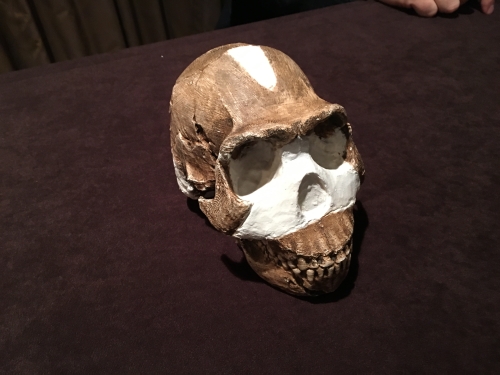
Homo naledi skull replica.
Sixty biologists in a New Orleans hotel conference room with a paleoanthropologist, a replica of an early hominin skull, and a revised story of our human ancestry? Does it get any better than that?
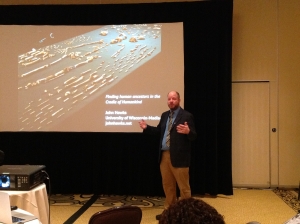
John Hawks at BLC 13
Last week, Dr. John Hawks (University of Wisconsin-Madison) gave the keynote address at the 13th annual Biology Leadership Conference in New Orleans, LA. Hawks is part of the team that, in 2013, discovered the bones of a previously unidentified hominin species in a South African cave. The name of the new species, Homo naledi, refers to the Rising Star cave where the bones were found (“naledi” means “star” in the local Sethoso language).
Among his other academic qualifications, Hawks is a mighty good storyteller. He held us spellbound with the Rising Star story… It started in 2013 with two local cavers who, under the guidance of Lee Berger (from the University of Witwatersrand and the principal investigator on the Rising Star project), were systematically exploring caves in an area know as the “Cradle of Humankind“, a UNESCO World heritage site about 30 miles northwest of Johannesburg, South Africa. Deep underground, they found a narrow opening (7.5 inches wide) that led to the chamber where the bones were found. They snapped a few pictures, took them to Berger, who immediately recognized the importance of the find when he could see a skull and a mandible that were clearly hominin.
We know that living apes, chimpanzees and humans are close relatives to each other, with nearly identical genomes, but we humans are even more closely related to Australopithecus and other extinct human ancestors. Researchers know that the evolutionary lineage leading to humans diverged from the other apes somewhere around 6 or 7 million years ago. The species in that diverged group are collectively referred to as hominins, a group consisting of modern humans, extinct human species, and our immediate ancestors.
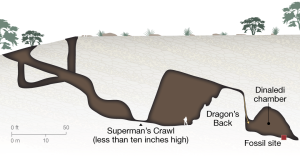
The path to the chamber. (source: National Geographic)
Looking at that photo of a clearly hominin specimen and listening to the cavers’ description of where they found it, Lee was faced with the difficult question of how to get in there and, even more of a challenge, how to get the bones out? Getting to the spot requires a 150-foot initial descent, a “superman crawl” through a 10″ high tunnel (so named because you have to navigate it with one arm up in order to squeeze through), then a steep climb up a stone wall (called the Dragon’s Back), followed by a descent through a 7.5 inch wide, 40 foot-long vertical chute into the chamber – and all done in the absence of natural light, without a safety harness (there’s no room!).
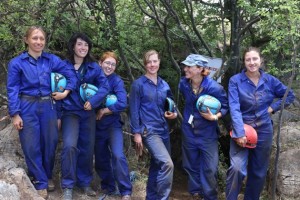
Underground astronauts (source: National Geographic)
Berger knew that he would need a very special team to pull this off. So, in October 2013, he posted a request on Facebook, calling for experienced paleontologist/archeologists with caving experience who were not claustrophobic, who could drop everything and come to South Africa for a few months, and who were small enough to fit through a 7.5 inch tunnel. Quite the list of specific job requirements! He received 57 applicants – all qualified – and from there, he picked six. The so-called “underground astronauts” pictured here. All women. All experienced professionals. And all able to wriggle their way through that narrow chute.
On the strength of their find, the scientists reached out to the National Geographic Society and the expedition was on. By November, a 60-person camp was set up and running by the Rising Star Cave.
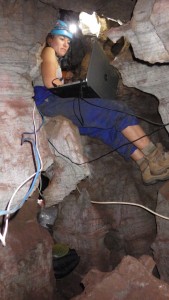
Photo by Elen Feuerriegel.
And down they went. What is it like to work inside this cave? Hawks described cramped and claustrophobic conditions, razor-sharp rocks, dust, darkness, and a tangled mass of cables and cords with which the team has wired the site. Have a look at this National Geographic video to get a feel for getting into the chamber. The careful removal of 100’s of bones must be done while documenting their found-placement, all the while gingerly maneuvering so as not to disturb the site. The expedition’s National Geographic blog site gives a feeling for the work with stories aplenty recounting their day-to-day challenges and showcasing the teams impressive problem solving. I’m particularly fond of this award-winning photo, taken by Elen Feuerriegel (one of the astronauts) showing the scanning set up inside the cave. Before excavating, each area is carefully scanned to create a 3D-rendered image for reference. In this photo, Lindsay Eaves monitors the scanner on a laptop, while precariously perched in a fissure while her colleague, Becca Peixotto, operates the scanner, off-camera to the right.
Over the course of the first 20 days the astronauts pulled up 1200 specimens from 15 individual skeletons – painstakingly, carefully, piece by piece. To put this into perspective, finding one complete skeleton of a previously unidentified hominin would be miraculous; to find 15 is simply unheard of. Before the Rising Star expedition, the only early hominins we had were Lucy (40% of an Australopithicus skeleton), Turkana boy and one skeleton of Australopithicus sediba (also found by Lee Berger) – that was it. The skeletal record of human ancestry. With this first find (and they’re still digging) they have one complete skeleton (except for two small bones) and multiple copies of most all of the bones. They have 107 foot elements, 190 teeth, 150 wrist and hand elements, skulls, mandibles, limb bones. What’s more, they appear to have remains from a variety of individuals – male, female, toddlers, adolescents, and older individuals (old = 35 years).
So what have they learned about the specimens so far? From the remains the scientists can estimate that an adult H.naledi was about four and a half feet tall, roughly 80 – 110 lbs in weight. There are aspects of H. naledi that are very human-like. For instance, they have human-sized teeth, human-proportioned limbs and arched feet (making it possible to be a good long distance walker), and human-like wrist anatomy. But they also have many important ape-like qualities like curved fingers for grasping, shoulders built for overhead reach and climbing, a flared pelvis, and most notably very small skulls (an H. naledi brain would be one-third the size of a modern human brain) with a forward-sloping face.
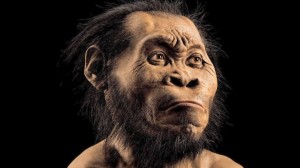
Artist’s rendering of Homo naledi (source: National Geographic)
Who is this creature? Could these fossil remains actually be a variety of species whose bones were jumbled up together in the same cave? The team quickly dismissed that idea since the various copies of any single bone were all the same. These specimens all have what Hawks refers to as a ‘mosaic of features’ from Australopithicus and Homid. In the same way that A. sediba (Berger’s earlier find) does. But here’s the thing – both naledi and sediba are mosaics, but they are different mosaics. Each has a different combination of australopith-like traits and human-like traits.
Where does H. naledi fall in the phylogeny? Is this an early human ancestor? Or could this be the last of a more primitive creature who was living among more modern humans? Maybe there is more diversity to the homo family tree than scientists thought? Maybe there are other fossils out there, with still other variations, that would even further complicate our family tree?
What makes this puzzle even more challenging is they have not yet been able to date the H.naledi remains. Are they 3 million years old or 30,000 years old? Typically paleoanthropologists position their finds in time by dating the surrounding rock or by dating faunal remains found with the specimens. In this case, there are no other faunal remains and the bones were found lying on the sediment surface, not embedded in rock. Not only that, the sediment can’t be dated because all the sediment in the cave came from the cave – there are no markers. Hawks explained that they might be able to obtain age estimations from dental enamel. They’ve also earmarked some of the bones for destruction in order to perform radiocarbon dating on them. Within a few months, Hawks says, they will have that data.
The Rising Star team has been extremely open with their findings. Scientists from all over the world have been invited to examine the fossils, their first article was published in the open access journal eLife, and the 3D printing files for 96 fossil specimens are openly shared on Morphosource, allowing anyone with access to a 3D printer to create their own H. Naledi fossil. The October issue of the National Geographic magazine is a great place to read the whole story and delight in the images.
Hawks closed his wonderful talk with a question for us to consider…what interpretation can we make of the placement of these bones? Why were they all together like this, without any other faunal remains, far beneath the earth’s surface, in a single cave chamber? Hawks assured us that they were not washed there by water. There are no marks on the bones that would indicate they were dragged there by an animal to be eaten. There is no debris in the cave that might suggest the creatures were living there. There are no other remains from other creatures. Could this be a burial chamber? Maybe living H. naledi took their dead to the cave’s opening and dropped them in? Was there a ritual involved, which would imply a culture and social behavior not typically associated with such a small-sized brain?
Clearly much remains to be discovered in the Rising Star cave. More bones to be found, timelines to be established, and meaning to be made. It was that very spirit of discovery and “not-knowingness” that struck me the most in Dr. Hawk’s talk. I lost track of how many times he said “We just don’t know…” during the 90 minutes he spent with us and what could be more inspiring than that? Even more exciting, it appears that we don’t even know what we thought we knew.

This serves as a great introduction to the topic and sterling summary story-telling for those of us who were unable to attend.
It also just occurred to me that their size aided their being able to access the location.
Excellent point – if they accessed the cave in the same way as the explorers are today. The structure of it might have been different in their time though.
No doubt some geological shifting but still…
The caves no doubt changed drastically during 1 or more mill.yrs: there’s no need for searching for “entrances”. Of course, there was no “deliberate burial”: it was a completely natural fossilization. The naledi hominids fossilized in mudstone. Mudstone forms in stagnant water. Naledi had curved hand-bones, an indication of vertical climbing. Stagnant water + trees = swamp forest. Some hominids (Pan, Homo, Gorilla) still spend some time in forest swamps, google e.g. bonobo wading. This explains also the humanlike flat feet (which are also present in prenatal Pan & Gorilla, see L.Bolk & C.Coon: it’s only after birth that chimps & gorillas get handlike feet). Naledi simply died where they lived, in the mud of the swamp, and the mudstone eroded into the cave system. They waded bipedally for aquatic plants etc. & climbed arms overhead in the branches above, like lowland gorillas & bonobos still do in forest swamps. In fact, naledi-like hominids have been predicted more than 10 years ago, e.g. Verhaegen, Puech & Munro 2002 “Aquarboreal ancestors?” Trends Ecol Evol 17:212-7, google e.g. aquarboreal.
Pingback: Digital Citizenship POE | doctorswaevee51com
Pingback: Digital Citizenship POE – deepinnermostinspirations
Pingback: Digital Citizenship POE – sowetokickssociety